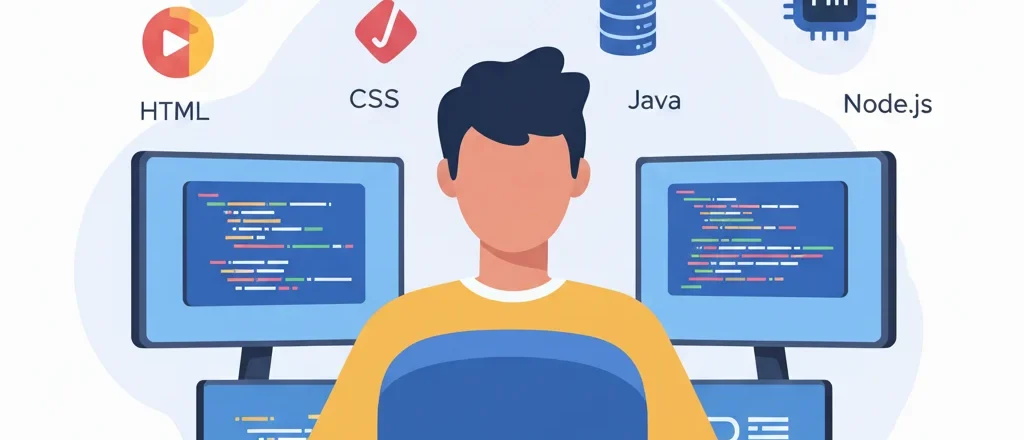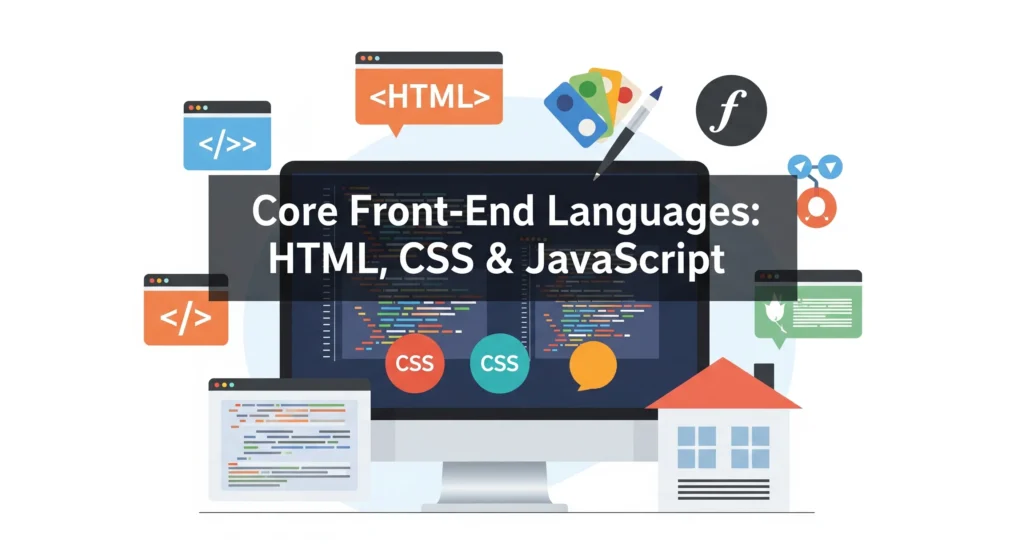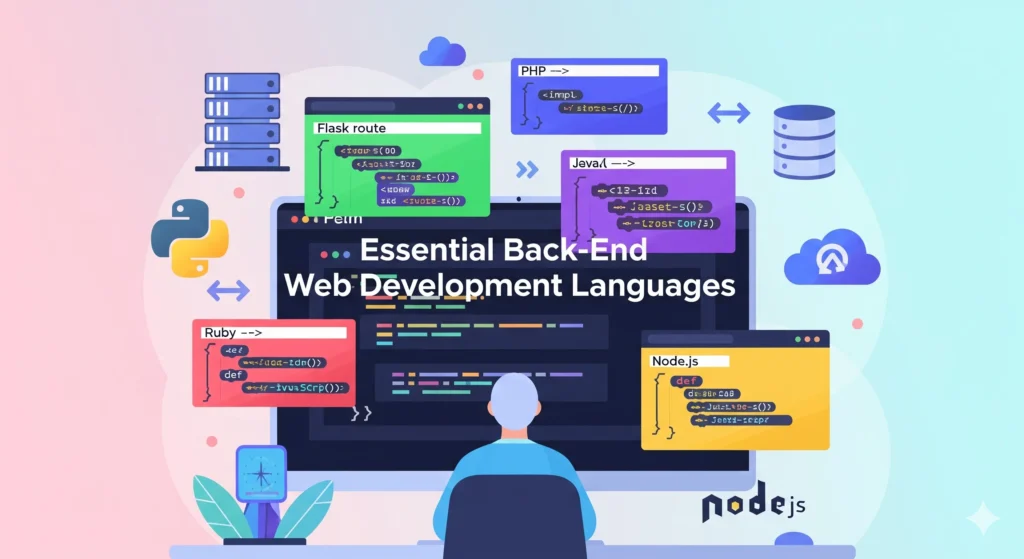
- By: Atif Latest News /
What languages should I learn first to get into web development?
Starting your journey in coding often feels overwhelming. There are countless programming languages out there, and beginners are usually unsure where to begin. Should you dive into something simple like HTML and CSS, or jump straight into powerful back-end languages like Python or Java? The confusion is real, and wasting time on the wrong choice can slow your progress.
The good news is, there’s a clear path forward. By understanding the most important web development languages and how they fit together, you can start with confidence instead of guesswork. Some languages are designed to help you build structure, others bring design to life, while a few handle the heavy lifting of databases and servers.
In this guide, we’ll walk through the essential languages, explain how they work in real projects, and show you exactly which ones are worth learning first. By the end, you’ll know how to kickstart your development journey with the right skills, and more importantly, why those skills matter in building modern websites and applications. For more AI-powered solutions and digital growth strategies, visit XtreemeTech.
Table
Language | Type | Primary Use | Examples of Use |
HTML | Front-End | Structure of web pages | Content layout, forms, text |
CSS | Front-End | Styling and design | Colors, fonts, responsive design |
JavaScript | Front-End/Full | Interactivity and dynamic content | Animations, dropdowns, real-time updates |
Python | Back-End | Server-side programming, AI, data handling | Django apps, AI chatbots, analytics |
PHP | Back-End | Dynamic web scripting | WordPress, e-commerce websites |
Java | Back-End | Large-scale and enterprise applications | Banking apps, enterprise portals |
Ruby | Back-End | Fast and clean web app development | Startups, MVP apps (Rails) |
Node.js | Back-End/Full | JavaScript on the server | Chat apps, streaming platforms |
GoLang | Back-End | High-performance, scalable web tools | Cloud services, APIs |
Rust | Back-End | Memory safety, high-performance apps | Secure systems, performance-heavy apps |
Core Front-End Languages
Core Front-End Web Development Languages form the base of every website. They define structure, add design, and bring interactivity, making sites functional and engaging.
HTML
Every website begins with HTML (HyperText Markup Language). It creates the skeleton of a page—headings, paragraphs, links, forms, and images. Without HTML, there’s nothing for users to see. Think of it as the foundation of a house.
CSS
Once the skeleton is there, CSS (Cascading Style Sheets) adds design—colors, fonts, layouts, and responsiveness. This is what makes a site look professional instead of plain text on a screen. CSS is the paint and decoration of your digital house.
JavaScript
JavaScript adds the magic. Interactive buttons, animations, dropdown menus, and real-time updates all happen because of JavaScript. It’s everywhere—used by websites like YouTube, Facebook, and Twitter to keep things engaging.

Quick View: What Real Developers Say
Most developers agree the best starting point is HTML, CSS, and JavaScript. Once those basics are solid, adding TypeScript or Node.js helps you grow into a full-stack path.
- Start with the front-end trio. Most developers begin with HTML → CSS → JavaScript. This path teaches structure, style, and logic in a clean order. Browsers run JavaScript natively, so you see results fast. That feedback loop keeps you motivated.
- Why this order works. HTML builds the page, CSS makes it look right, and JavaScript adds behavior. You learn the box model, layout, DOM, events, and APIs step by step. These skills transfer to every framework you’ll meet later.
- Add TypeScript once JS feels comfy. TypeScript adds types on top of JavaScript. It catches common bugs early, improves editor hints, and scales better for team work. Many React and Angular codebases use it.
- Pick up Node.js for the server. Sticking with JavaScript on the back end speeds learning. With Node.js you build APIs, talk to databases, and share code patterns across the stack. Express and NestJS are frequent choices.
- CSS help is normal. Many devs lean on Tailwind CSS or Bootstrap after learning raw CSS. These tools speed up layout, spacing, and components without hiding the basics.
- Frameworks come later. After the core, choose one: React, Vue, or Angular. React leads in job posts and ecosystem size; Vue feels friendly; Angular offers a batteries-included approach. Any one can get you productive.
- Tooling that pays off. Use VS Code, Git and GitHub, browser DevTools, and a bundler like Vite. Learn npm (or pnpm). These tools save hours and make projects feel professional.
- First project ideas. Build a portfolio, a to-do app, a notes app with localStorage, then a small API with Node.js. Ship it, share it, and iterate. Real work beats passive tutorials.
- Common traps to avoid. Don’t hop between ten frameworks. Don’t skip accessibility or semantic HTML. Don’t copy-paste code you can’t explain. Small, steady projects win.
- How this maps to jobs. Most listings ask for strong HTML, CSS, JavaScript plus one framework and Git. Back-end roles often add Node.js, Python, or Java and a database (PostgreSQL or MongoDB).
Master the front-end trio first—it’s the foundation of every site. From there, branch into TypeScript, Node.js, and a framework to become job-ready.
Essential Back-End Languages to Learn Next
Front-end gives your site a face, but back-end web development languages keep everything running behind the scenes—handling data, servers, and user requests. Once you’ve built the basics with HTML, CSS, and JavaScript, learning at least one back-end language is the natural next step. Here are the most popular choices:
Python – Simple and Versatile
Python is often recommended for beginners because of its clean syntax. Frameworks like Django and Flask make it easy to create secure, scalable web apps. It’s also widely used in AI, data science, and automation, which means learning Python can open doors beyond just web development.
PHP – Web-Friendly and Flexible
PHP has been powering the web for decades and still runs a huge portion of websites. It integrates directly with HTML, making it great for building dynamic pages quickly. Platforms like WordPress and Drupal are written in PHP, so if you ever work with content-driven websites, this language will be useful.
Java – Reliable for Enterprise
Java is built for big, complex systems. It’s secure, stable, and works well for applications that need to support millions of users. Large enterprises and industries like banking, e-commerce, and healthcare trust Java for their mission-critical software.
Ruby – Fast and Developer-Friendly
Ruby, especially when paired with the Rails framework, is loved for its simplicity and speed. Developers can build apps quickly without writing too much repetitive code. This makes it a popular choice for startups that want to launch products fast.
Node.js – JavaScript Beyond the Browser
Node.js takes JavaScript from the browser and brings it to the server. This means you can use the same language for both front-end and back-end development. It’s especially powerful for building real-time applications like chat systems, online games, or live streaming platforms.

Popular Full-Stack Language Combos
Being a full-stack developer means you can handle both the front-end (what users see) and the back-end (what powers the app behind the scenes). Modern web development often blends multiple web development languages together to create complete, scalable solutions.
Here are the most common and effective combos in 2025:
HTML, CSS, and JavaScript + Python
This combo is a favorite among beginners and professionals. HTML, CSS, and JavaScript handle the user interface, while Python—using frameworks like Django or Flask—manages the server, databases, and logic. It’s clean, versatile, and beginner-friendly.
HTML, CSS, and JavaScript + PHP
PHP has been powering content-heavy websites for years. Paired with front-end basics, it’s ideal for dynamic sites and works especially well with CMS platforms like WordPress. This combo is perfect for developers building blogs, portfolios, or e-commerce websites.
HTML, CSS, and JavaScript + Java
This mix is often chosen for enterprise-level applications. The front-end takes care of usability, while Java ensures stability and security on the back-end. Companies needing large-scale, robust systems prefer this stack.
HTML, CSS, and JavaScript + Ruby
Ruby on Rails paired with the front-end trio makes for quick and efficient development. Startups and small businesses often choose this combo because it allows faster product launches without compromising quality.
HTML, CSS, and JavaScript + Node.js
This is one of the most popular full-stack choices today. Since Node.js uses JavaScript on the server, developers only need to master one language across the entire stack. It’s powerful for building real-time applications like chat apps, streaming platforms, and collaborative tools.
Emerging Languages in Web Development
Technology is evolving fast, and new programming languages are gaining popularity. While not as universal as HTML, CSS, or JavaScript, they are shaping the future of modern web applications.
Go (GoLang)
Go is known for its speed, scalability, and efficiency. It’s often used in cloud-native applications, containerized environments, and tools that need to handle heavy traffic without slowing down.
Rust
Rust is gaining momentum thanks to its performance and safety features. It’s especially valuable in projects where memory management and high performance are critical, making it a strong choice for demanding web services.
Kotlin
Originally designed for Android, Kotlin is now being used in backend web development as well. Its concise syntax and strong support from major companies make it an attractive option for building reliable web services.
How to Choose Your First Language
Choosing the right programming language depends on your goals and project type. Each language has unique strengths, so focus on where you want your journey to begin.
- Personal Projects or Portfolios → Begin with HTML, CSS, and JavaScript. These three are enough to create clean, functional, and interactive websites.
- Startups or Small Businesses → Add Python or Node.js for flexibility and quick development. Both are great for building MVPs (minimum viable products).
- Enterprise-Level Projects → Consider Java or C#. They are powerful, scalable, and widely trusted for large applications.
Along with the type of project, also look at:
- Community Support → A larger community means more tutorials, answers, and libraries to speed up your learning.
- Learning Curve → Some languages are easier for beginners, while others require more time to master.
- Resources Available → Check if there are courses, frameworks, and tools to help you build faster.
Step-by-Step Learning Roadmap
Getting into web development languages is less overwhelming if you follow a clear path. Here’s a roadmap most beginners find effective:
- Start with HTML → Learn how to structure content with headings, paragraphs, links, and forms.
- Move to CSS → Add design with colors, layouts, fonts, and responsive styling.
- Learn JavaScript → Make your pages interactive with buttons, animations, and dynamic updates.
- Pick a Back-End Language → Once front-end basics are strong, choose Python or Node.js to start building functional applications.
- Explore Frameworks → Try React for front-end, Django/Flask for Python, or Ruby on Rails for Ruby to speed up development.
- Build Small Projects → Create a blog, portfolio site, or simple to-do app to practice and apply skills.
- Engage with Communities → Join GitHub, Reddit, or developer forums to share projects, get feedback, and stay updated.
FAQs
What are the most important languages for beginners?
The top three are HTML, CSS, and JavaScript. These give you the foundation for building structure, styling, and interactivity in websites.
Which back-end languages should I learn after front-end?
Popular options include Python, PHP, Java, Ruby, and Node.js. The choice depends on your project goals and long-term plans.
Are emerging languages like GoLang or Rust worth learning?
Yes, but only after mastering the basics. GoLang is used for scalable apps, while Rust is gaining popularity for performance and security.
Can I become a full-stack developer by learning only one language?
Yes, with JavaScript and Node.js you can handle both front-end and back-end, making you a full-stack developer.
How long does it take to learn?
With consistent practice, you can learn HTML, CSS, and JavaScript basics in 3–6 months. Adding a back-end language might take another 6 months, depending on your pace.
Conclusion
Learning web development isn’t about mastering every programming language overnight. It’s about starting with the right ones, building projects, and adding skills as you grow. HTML, CSS, and JavaScript give you the foundation, while back-end options like Python, Java, or Node.js expand your possibilities.
The more you experiment, the clearer your path becomes. Stick with the process, keep coding, and the skills you learn today will shape the projects you build tomorrow. For comprehensive tutorials and official documentation on web technologies, check out MDN Web Docs.
